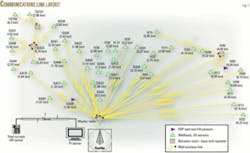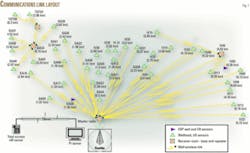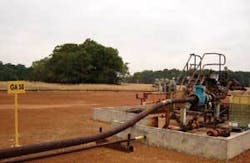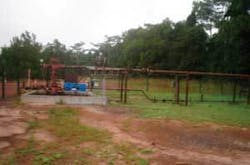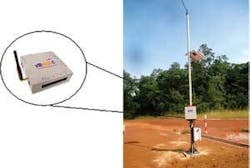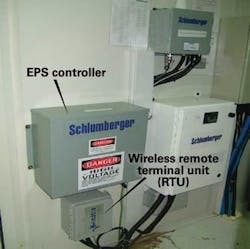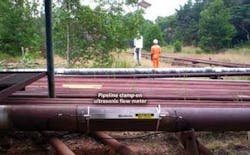Wireless technology is a critical component in “smart-field” operations, such as in producing fields operated by Shell in Gabon, West Africa.
Shell’s smart-field vision has many intertwined technology and business methodology components that extend from downhole systems, to well surface equipment, and to a variety of tools in the office for analyzing and optimizing production operations. A key prerequisite for implementing any integrated smart-field system is the ability remotely to capture well and other critical asset data and remotely to control processes at the wellsite.
Shell worldwide has several on-going smart-field implementations. In two major initiatives in West Africa-in Nigeria and Gabon, each implementation has a different scope and objective.
Remote operations are critical in any smart-field implementation. Because most, if not all, wells are remote especially in countries such as Gabon, implementing smart-field technology requires wireless technology.
In most upstream applications, connecting remote wells and other remote assets via a physical connection, such as fiber-optic cable along a pipeline, has proven impractical, very expensive, and extremely difficult to maintain because of potential cracks in the fibers that render the entire fiber link useless. For such reasons, the petroleum industry generally agrees that the only viable option to link many remote sites is with wireless technology.
Wireless technology, however, has major obstacles in environments such as West Africa, where dense and high vegetation impede radio signals.
As a result, the industry requires a new generation of wireless technology to link effectively these remote wells to the office.
Smart digital oil field
Many major oil and gas companies have adopted the “digital oil field” strategy. These strategies have various names in the industry. Shell calls it the “smart-field,” while other companies call it “I-field,” “field of the future,” or other names.
The aim of all these strategies is to extract more oil and gas from existing reservoirs through implementation of smart technologies and processes. These technologies can be placed in the wellbore, at the wellhead, and in the office.
The technologies include intelligent well technology and production optimization software. The industry has various estimates on the worth of smart digital oil field. Some predictions are that the technology can:
- Improve ultimate recovery by 1-5%.
- Accelerate production by 2-8%.
- Reduce downtime by 3-10%.
- Improve operating efficiency by 5-20%.
These are significant numbers, given these technologies can be implemented at a fraction of the investment needed for exploring, drilling, and producing new fields.
In addition to these benefits, many companies such as Shell Gabon face major operational challenges and want fully to automate their assets because of the harsh nature of their environments. Wells are too remote to reach, which affects their ability to detect problems such as well shut-in. Weather conditions in such locations prevent operators from visiting wells because of heavy rains that go on for several days and weeks at a time. In other Shell West Africa operations such as Nigeria, security is major issue.
System overview
Shell Gabon operates several fields in Gabon, one of which is Gamba field. Most wells in Gamba field are on artificial lift.
With production in Gamba declining, Shell put forward a smart-field strategy for implementing several new technologies for stabilizing and ultimately increasing production for the field. Installing a remote operation system was the first step in overall system implementation (Fig. 1).
The main part of the system includes remote monitoring and control of gas-lift wells, electric submersible pump (ESP) wells, and pipeline gas flow
On each gas-lift well (Fig. 2), the system had to measure tubinghead pressure, casinghead pressure, tubing temperature, differential pressure (gas-lift flow line), and annulus pressure.
The monitoring system on the ESP wells (Fig. 3) required an interface to the ESP surface controllers, the ability to extract critical ESP parameters such as motor frequency, motor current, motor voltage, and other motor parameters.
The system also transmits various downhole measurements such as pump intake and discharge pressure and temperature, vibration, current, and several other parameters.
To verify and regulate injected gas, the operator needed to measure pipeline flow to complement the other measurements from the gas compressors and the wells.
The pipeline measurement system is a nonintrusive clamp-on type with an ultrasonic meter.
Remote operations
The implemented system has the following major components:
- Data-acquisition system to interface to well sensors (pressure, temperature, and differential pressure), ESP controllers, and pipeline measurement system.
- Wireless communication subsystems to interface to the data-acquisition system.
- Nonintrusive flow measurement meter for the gas pipeline.
- A gateway to receive data from the wells and the pipeline and to send control commands back to the wells.
- Software to manage the data, provide reports and alarms, enable operator control, and provide interface to other systems and databases.
- Data historian, to be implemented in the future.
- Smart-field production optimization software, Shell FieldWare, also to be implemented in the future once the data stream becomes available.
Wireless communication
The wells are spread out in a geographic area with a radius of about 10 km. Under normal circumstances with clear line of sight between the wells and main communication towers, a wireless communication system should easily operate over a 10-15 km range. The thick jungle vegetation in Gabon, however, renders the system inoperable at 3-4 km.
To deal with these limits, Shell Gabon, decided to install a new generation of wireless remote terminal units called vMBusX-C (Fig. 4) from vMonitor Inc. The units deliver a high-power output signal, but delivering extra transmission power is insufficient by itself in this case.
The vMBus wireless system also has intelligent processing and multihoping capabilities to carry the signal from well to well to the base station.
Higher output radios deliver better performance, but these systems have a limited 5-km range. Because most units could not communicate directly from many of the wells back to the main control station, the system required that each vMBus unit installed at each well act as a self-repeater whenever it detected a signal from a nearby well.
This approach allows the signal to carryover over several short hops, each 3-4 km, until it reaches the main station.
System integration
The new remote operations system must monitor and control various subsystems. Some subsystems, such as for the ESPs, already existed (Fig. 5). Other subsystems were installed as part of the new remote operations system. The pipeline ultrasonic flowmeters were one of these (Fig. 6).
The ESPs were from Schlumberger Reda, while Controlotron (Siemens) provided the pipeline ultrasonic flowmeters and Fisher Rosemount provided the wellhead instrumentation,
With different vendors involved, the system needed a great deal of integration work at the hardware and software levels to ensure data compatibility and system operability.
Data capture, visualization
A gateway installed at the Gamba base station tower captures the data transmitted from all the wells. The gateway connects to a server hosting TotalAccess software. TotalAccess is a web-based host software with a polling engine, a data visualization system, and an OLE (object linking and embedding) for process control (OPC) server that will data interface to other software systems. TotalAccess provides real-time, well data, well diagnostics, reports, and alarms (Fig. 7).
The system connects to the Shell network so that anyone in the world with proper Shell security permission can have web-based access to the system.
System installation
Shell Gabon completed installation of the system in mid-2006. Since then, it has delivered reliable real-time data from all wells in Gamba field.
Data captured by this system will be interfaced to various smart-field production optimization software. Shell Gabon’s goal is for this system to help achieve a 3% production gain annually during the next few years.
The system already has delivered several operational cost savings.
The authors
Hatem Nasr is cofounder of vMonitor. Previously, he was technology director at Baker Hughes and principal scientist at Honeywell Technology Center. Nasr holds a PhD in computer engineering from the University of Minnesota and a BS and an MS in systems engineering from the University of Houston.
Jose Rincon is an engineering manager at vMonitor, Houston. He was the project manager for vMonitor Shell Gabon project and has worked on several vMonitor wireless SCADA systems installations around the world. Before joining vMonitor, Rincon worked with Emerson Automation in Venezuela. Rincon holds a BS in electronic engineering from University of Maracaibo in Venezuela and an MS in automation and process control from Rafael Belloso Chacín University in Venezuela.
Robert Clinton is a senior engineer in Shell E&P. He was the project lead for the remote operations project in Gamba field and worked in Shell Gabon on several projects in Rabi, Toucan, and Gamba fields. Before Shell Gabon, he worked with Shell Expro. Clinton is currently working in PDO Oman.
